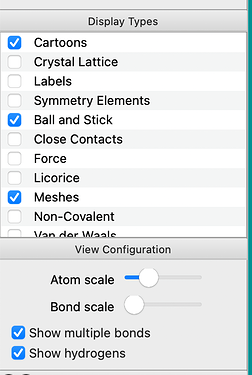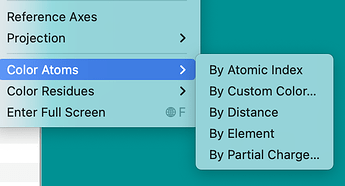We will once again apply to be a part of Google Summer of Code 2022.
Last year, Marc added both ribbon / cartoon rendering and the layer system.
I’ve posted a few ideas to the Open Chemistry wiki:
- Python scripting (i.e., both a terminal and running scripts, e.g., rendering a movie from rotating a molecule)
- Integration with RDKit (e.g., for coordinate generation using ETKDG, optimizing with UFF / MMFF94, etc.)
- Fast, efficient molecular surfaces / orbitals
- Interactive molecular dynamics - improving on the “auto-optimize” in Avogadro v1, it would be great to apply a temperature and watch a system evolve … even if you pull/push on an atom or molecule
- Generating “systems” like packed membranes, MOF or COF frameworks, etc.
Other ideas or suggestions?
This is a great list, @ghutchis! I can add some ideas:
- Fragments to insert, and it will be good if we can point to the exact atom where to put them
- Rendering styles as in VMD
- Labels for atoms/amino acid residues
- Generation of high-resolution images. Also, vector images would be highly appreciated, since I never saw an application that can generate them correctly.
- Geometry optimization and MD with periodic boundaries. Building them from scratch is a huge pain!
- Surfaces! Not only orbitals, but ESP with coloring, .cube data…
- Vibrations and IR spectra
- Non-covalent interactions, from quantum chemistry output or based on protein-ligand complex
Sadly, many functions in v.1.90 are not working properly for me, so it would be great to fix them, too.
1 Like
Can you describe this a bit more?
A few other comments:
- Fragments to insert, and it will be good if we can point to the exact atom where to put them
This is coming. I have a new fragment builder tool. You’d be able to point to one atom (or more, e.g. bidentate ligands)
- Labels for atoms/amino acid residues
This was part of last year’s GSoC. There’s even a new label tool to add custom labels to atoms.
- Generation of high-resolution images. Also, vector images would be highly appreciated, since I never saw an application that can generate them correctly.
Marc added a simple SVG export, but we can definitely build on that.
- Surfaces! Not only orbitals, but ESP with coloring, .cube data…
Cube data should already work, but yes, the project for surfaces would include mapping properties, ESP, etc.
- Vibrations and IR spectra
You can animate vibrations now, but plotting spectra is important. Actually, I should go add that to the project list.
Thank you for the reply, I love to see that so many important features are coming to Avogadro. It’s probably too late for my comment, I apologize!
As for the rendering styles from VMD, its variety of options seems to me as an example for all other chemical software. It has about 20 representations (CPK, wireframe…), each with its own settings. Below are the settings for balls and sticks representation, which helped me a lot in rendering large periodic systems and finding balance between quality and speed of rendering.
As an additional suggestion from quantum chemistry side, I would be happy to have integration with the programs for the processing of
ab initio results, such as
Multiwfn,
NCIPLOT, etc.
Our new rendering system doesn’t require a resolution. It can easily handle hundreds of thousands of atoms and bonds on modern hardware.
If you click on a particular display type, the configuration comes up:
Changing atom colors (or for only a set of selected atoms) is under the View menu:
Thank you, I’ll have a look!


